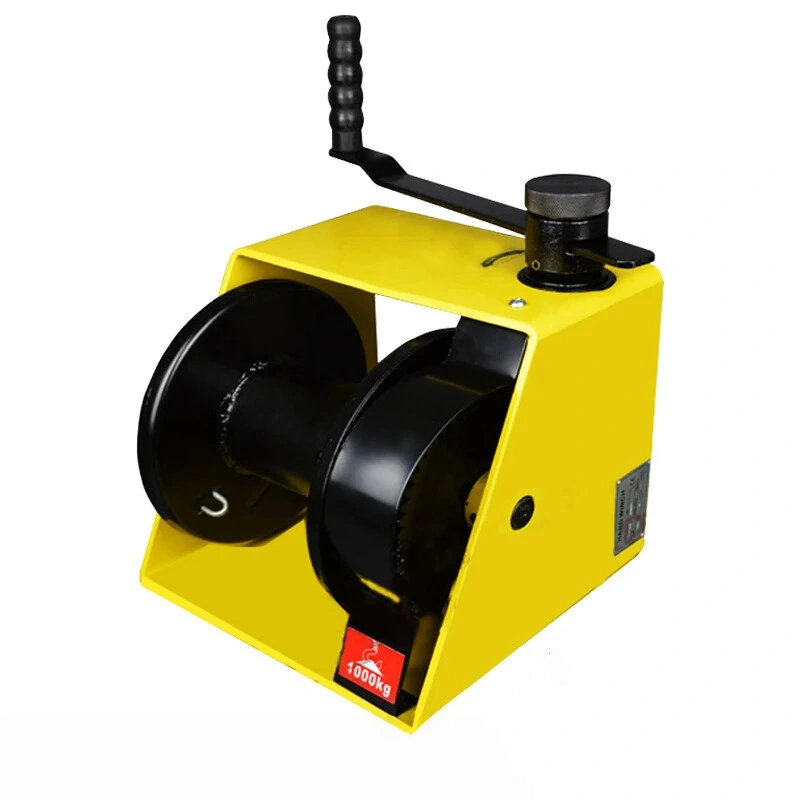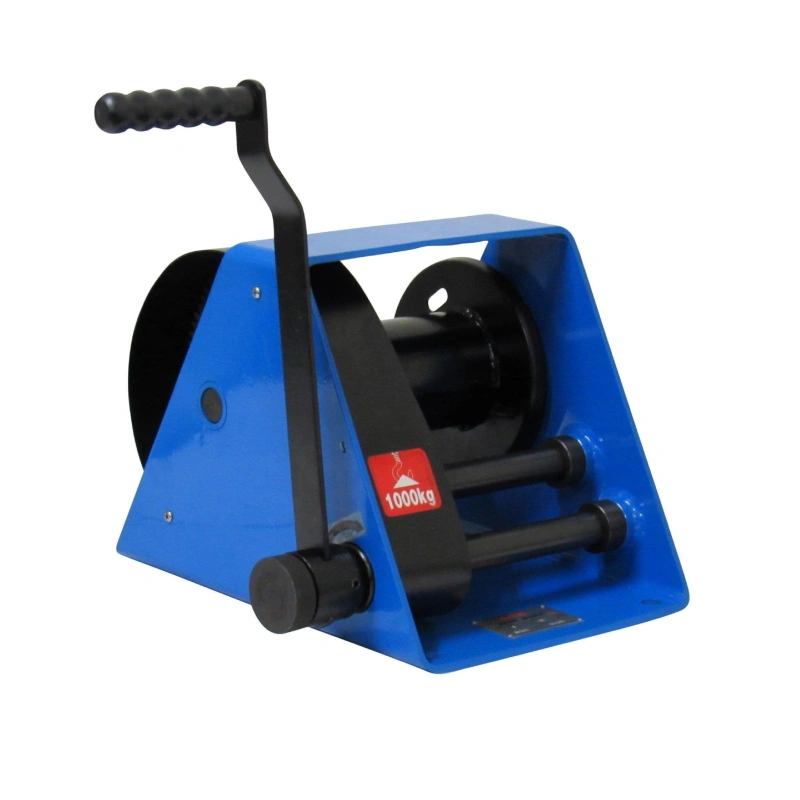You need anchor chain grades like G30, G40, G43, and G70 for reliable performance in marine applications. Choosing the right anchor chain helps you protect your vessel and improve safety.
Powerful Machinery delivers certified solutions trusted by professionals worldwide. Select the correct grade to ensure durability and maintain confidence during every voyage.
Key Takeaways
Choose the right anchor chain grade for your vessel. Grades like G30, G43, and G70 indicate strength and suitability for different marine tasks.
Select certified anchor chains to ensure safety and reliability. Look for products that meet international standards like ISO and RINA.
Regularly inspect and maintain your anchor chains. Cleaning and checking for wear can extend their lifespan and prevent failures.
Consider environmental conditions when selecting materials. Galvanized and stainless steel chains offer better corrosion resistance in saltwater.
Customize your anchor chains to fit your specific needs. Tailored options enhance performance and safety for your vessel.
Anchor Chain Grades Overview
What Are Anchor Chain Grades?
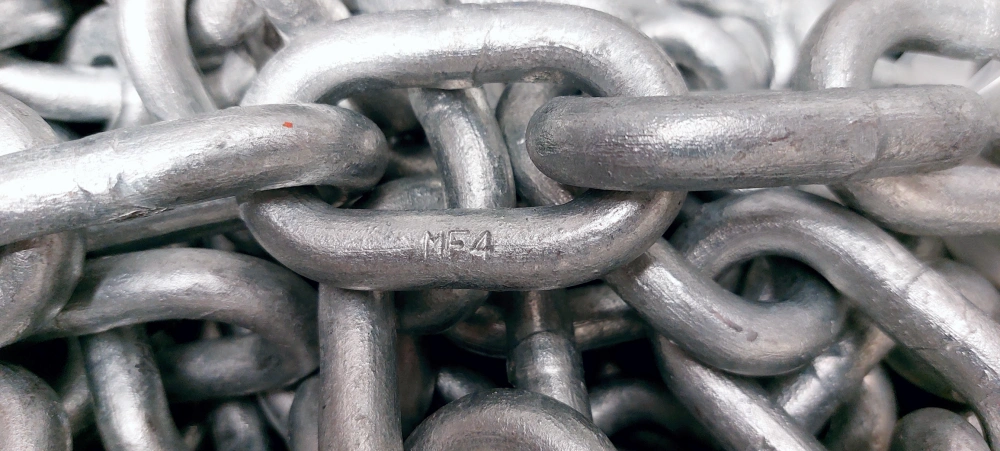
You encounter anchor chain grades when selecting chains for marine applications. These grades indicate the strength, composition, and intended use of each chain. Manufacturers use chain grade numbers such as G30, G43, and G70 to help you identify the right product for your needs.
The grading system ensures you match the chain’s performance to your vessel’s requirements.
Here is a quick comparison of common chain grades:
Chain Grade | Description | Applications | Strength Characteristics |
|---|---|---|---|
G30 | Lowest grade, also known as proof coil. | Logging, trucking, tie downs, and playground equipment. | Basic strength, not for overhead lifting. |
G43 | Higher strength-to-weight ratio than G30, known as High-Test Chain. | General utility, towing, load securement. | Moderate strength, interchangeable with G30. |
G70 | Highest grade in carbon chain category, heat-treated for durability. | Tie down and load securement for trucking. | High strength-to-weight ratio, not for overhead lifting. |
You see anchor chain grades used to classify chains for different marine tasks. G30 chains offer basic strength for lighter jobs.
G43 chains provide moderate strength and versatility. G70 chains deliver high strength for demanding environments. You should always check the grade before making a purchase.
Note: The anchor chain market is evolving. Stricter safety and environmental regulations now require certified, corrosion-resistant chains. You benefit from advanced alloys and composite coatings that improve resistance to seawater.
Smart anchoring systems with GPS and load sensors are also becoming more common, helping you optimize anchor deployment and safety.
Powerful Machinery Anchor Chains
You find a wide selection of anchor chain grades at Powerful Machinery. The product range includes Studless Anchor Chains, Stud Link Chains, and other anchor chains designed for marine use. Each chain meets international standards such as ISO, RINA, and BV.
You can choose chains made from galvanized steel, stainless steel, or alloy steel, depending on your application.
Studless Anchor Chains provide flexibility and easy handling. Stud Link Chains offer extra strength for heavy-duty anchoring. Powerful Machinery ensures every chain passes rigorous testing for durability and corrosion resistance.
You receive certified products that perform reliably in harsh marine environments. Customization options allow you to select the right length, material, and finish for your vessel.
You gain peace of mind knowing that Powerful Machinery anchor chains meet the highest safety and performance standards. The company’s commitment to quality helps you protect your vessel and crew during every voyage.
Marine Chain Standards
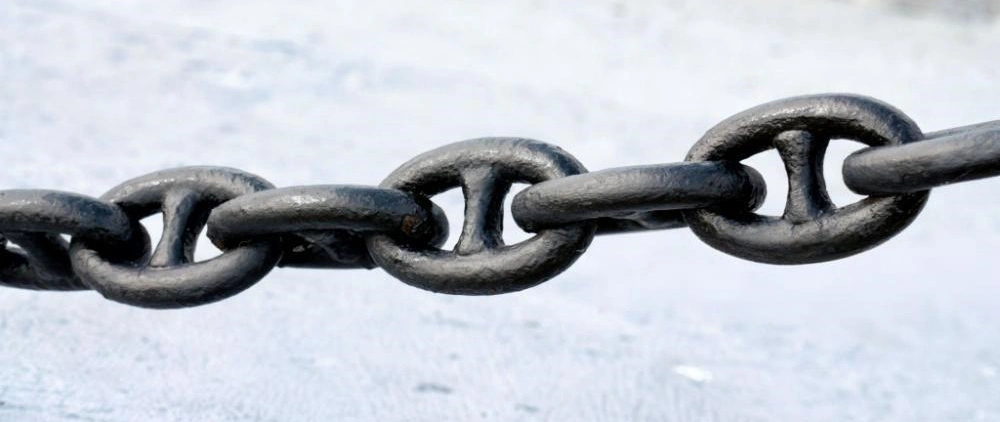
International Certifications
You rely on international certifications to ensure anchor chains meet strict safety and quality requirements. These certifications confirm that chains have passed rigorous testing and comply with recognized marine chain standards. The most important standards include ISO 1704, RINA, and BV.
These organizations set benchmarks for manufacturing, testing, and performance. You can review the table below to see key standards and their descriptions:
Standard | Description |
|---|---|
ISO 1704 | International standard for anchor chain manufacturing and testing |
GB/T549 | Chinese National standard for marine chains |
CCS | Classification society from P.R. China |
LR | Classification society from the U.K. |
GL | A classification society from Germany |
ABS | Classification society from the U.S.A. |
DNV | A classification society from Norway |
NK | A classification society from Japan |
BV | A classification society from France |
RS | A classification society from Russia |
RINA | Classification society from Italy |
KR | Classification society from Korea |
You benefit from Powerful Machinery’s commitment to these standards. Every anchor chain undergoes strict testing for strength, durability, and corrosion resistance. You receive products certified by RINA and BV, which means your chains meet global safety expectations.
Tip: Certified chains help you avoid unexpected failures and ensure your vessel remains secure in challenging conditions.
Material and Corrosion Resistance
You need anchor chains that resist corrosion and maintain strength over time. The choice of material affects how well a chain performs in saltwater and harsh environments.
Manufacturers use high-tensile marine-grade alloy steel, galvanized steel, and untreated steel for different applications. The table below shows how each material impacts corrosion resistance:
Type of Chain | Material Used | Corrosion Resistance Effect |
|---|---|---|
High-tensile marine-grade alloy steel | Alloy steel | High strength and corrosion resistance |
Galvanized chains | Hot-dip coated steel | Enhanced corrosion protection in saltwater |
Black chains | Untreated steel | Lower corrosion resistance, suitable for freshwater or cost-sensitive applications |
You notice that galvanized chains offer strong protection in saltwater but may experience electrolysis, which can degrade the zinc coating. When the zinc layer wears away, the steel underneath becomes vulnerable to rust. Mechanical disturbances from anchoring also affect seabed habitats, including seagrass and coral reefs.
You gain confidence with Powerful Machinery’s anchor chains. The company uses advanced materials and coatings to maximize corrosion resistance and durability. You protect your vessel and contribute to safer marine operations by choosing certified products.
Anchor Chain Grades Comparison
Strength and Durability
When you select anchor chains, you must consider both strength and durability. Each grade offers a different minimum tensile strength and working load limit. These factors determine how well the chain performs under stress and how long it lasts in marine environments.
The table below shows the minimum tensile strength for common anchor chain grades:
Grade | Minimum Tensile Strength (pounds) | Ultimate Tensile Stress (psi) |
|---|---|---|
G30 | 7,600 to 9,800 | Varies by manufacturer |
G40 | Not available | Varies by manufacturer |
G43 | Not available | Varies by manufacturer |
G70 | 13,999 to 15,938 | Varies by manufacturer |
You notice that G70 chains provide the highest minimum breaking strength and working load limit among carbon steel chain types. G30 chains offer basic strength, making them suitable for lighter tasks. The minimum tensile strength of each grade helps you match the chain to your vessel’s needs.
Durability depends on the material and coating. Galvanized chains resist corrosion, but damage to the coating can reduce their lifespan. Stainless steel chains, especially those made from 316 stainless steel, maintain their integrity even after prolonged exposure to saltwater.
Thicker galvanized coatings enhance protection and extend service life.
You must also consider failure modes. Chains can wear down, stretch, or suffer damage from frequent use and abrasion. Improper handling increases the risk of anchor chain wear and damage.
Anchor dragging, entanglement, and windlass malfunction can occur if you do not match the chain grade to your vessel and environment.
Tip: Always check the minimum tensile strength and working load limit before purchasing. This ensures your chain meets the demands of your anchoring system.
Typical Applications
You encounter different chain types in marine operations. Each type serves a specific purpose based on strength, flexibility, and corrosion resistance.
Studless anchor chains work well for yachts, recreational boats, floating pontoons, and aquaculture cages. You benefit from their ease of handling and weight savings. Offshore mooring systems also use studless chains for flexibility, although they are less common in heavy-duty applications.
Stud link chains are the preferred choice for large commercial vessels and offshore platforms. You rely on their robust design and high minimum tensile strength for secure anchoring in challenging conditions. These chains withstand high loads and resist twisting, making them ideal for demanding marine environments.
The table below summarizes recommended chain grades for different vessel types:
Vessel Type | Recommended Chain Grades |
|---|---|
Recreational Boats | Standard galvanized steel (U2/U3) |
Commercial Vessels | High-grade alloy steel, galvanized steel |
You see that recreational vessels typically use standard galvanized steel chains, which offer a reliable working load limit and corrosion resistance. Commercial vessels require high-grade alloy steel chains for maximum durability and strength.
Stainless steel chains provide superior corrosion resistance, but you may find them more expensive.
You must also consider the most common failure modes in marine environments:
Failure Mode | Description | Causes |
|---|---|---|
Anchor Chain Wear and Damage | The chain can wear down, stretch, or suffer damage, compromising its strength. | Frequent use, abrasion, improper handling. |
Anchor Dragging | The anchor fails to hold the vessel securely and begins to move. | Insufficient scope, poor seabed conditions, overloading, and anchor design. |
Anchor Entanglement | The chain becomes twisted or tangled, making retrieval difficult. | Improper deployment, crowded anchorages, and underwater obstructions. |
Anchor Windlass Malfunction | Malfunctions can make it difficult to raise or lower the anchor. | Mechanical failure, electrical issues, and overloading. |
Anchor Chain Jumping | The chain jerks or vibrates during anchoring operations. | Improper chain stowage, sudden changes in tension, and windlass misalignment. |
Anchor Loss | Losing an anchor can occur due to various reasons. | Chain breakage, improper attachment, and underwater obstructions. |
Anchor Setting Issues | Improper settings can lead to anchor dragging or failure. | Inadequate scope, unsuitable seabed, improper deployment. |
Anchor Chain Fouling | The chain becomes entangled with underwater objects. | Underwater obstructions, crowded anchorages, improper retrieval. |
Anchor Theft | Theft of anchors is a concern for vessel owners. | Exposure, high-traffic areas, and a lack of security. |
You reduce these risks by choosing the right chain grade and type for your vessel. Powerful Machinery offers studless anchor chains for flexible, lightweight applications and stud link chains for heavy-duty anchoring.
Both options meet international standards and provide reliable minimum tensile strength and working load limit.
Note: Always inspect your anchor chain for wear and damage. Regular maintenance helps you avoid unexpected failures and ensures reliable performance.
Choosing the Right Anchor Chain Grade
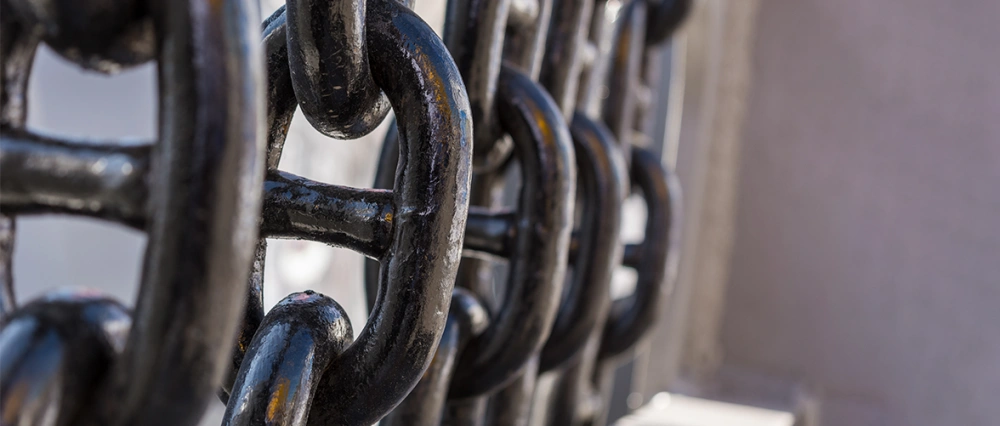
Vessel Size and Environment
Selecting the right anchor chain grade starts with understanding your vessel and its operating environment. You must match the chain’s strength and durability to the size and weight of your vessel. Larger vessels need thicker chains because they face greater windage and hydrodynamic forces.
You also require chains with higher holding power to prevent dragging, especially during storms or strong currents.
Consider these key factors when choosing an anchor chain for your vessel:
Vessel Size and Weight: Bigger vessels demand thicker and stronger chains.
Holding Power Requirements: Heavy vessels need chains with greater holding power for secure anchoring.
Material Strength: High-tensile steel chains deliver superior strength-to-weight ratios and resist corrosion, which is essential for long-term durability.
Environmental conditions play a major role in your selection. If you operate in warm, salty waters, you should choose duplex or super duplex stainless steel chains. These materials offer enhanced corrosion resistance and maintain performance in aggressive marine environments.
The Pitting Resistance Equivalent Number (PREN) and Critical Pitting Temperature (CPT) help you assess how well a chain will resist corrosion. Higher PREN values mean better protection against rust and pitting.
You benefit from stainless steel anchor chains in saltwater or corrosive conditions. These chains provide unmatched corrosion resistance, ensuring your anchoring system remains reliable over time.
Tip: Always evaluate your vessel’s size, weight, and the environment before selecting an anchor chain grade. This approach helps you maximize safety and extend the lifespan of your anchoring equipment.
Budget and Customization
Your budget influences which anchor chain grade you select. Different grades and materials come with varying price points. You must balance cost with performance to find the best solution for your needs.
Here is a comparison of anchor chain prices and attributes:
Product Name / Supplier | Price Range (Unit) | Material / Grade | Key Attributes |
|---|---|---|---|
30MM Ship Marine Mooring Anchor Chain | $0.30 – $0.35 / m | Steel | High volume supplier |
5/16″ 316 SS Anchor Chain w/ Shackles | $0.29 – $0.89 / kg | 316 Stainless | Stainless Steel |
316 SS Marine Anchor Chain | $5.70 – $6.20 / m | 316 Stainless | Mirror Polished |
Hot-Dip Galvanized U1-U3 Chain | $0.10 – $1.00 / m | Steel / U1-U3 | Very low price at 500m+ |
You notice that galvanized steel chains offer a cost-effective solution for most marine applications. Stainless steel chains, while more expensive, provide superior corrosion resistance and a polished finish. You must weigh the benefits of each material against your budget and operational requirements.
Powerful Machinery gives you access to a wide range of customization options. You can tailor anchor chains to fit your vessel type, anchoring system, and onboard storage needs. The company offers modular anchor designs that adapt to different seabed conditions and vessel sizes, enhancing safety and reliability.
You can integrate anchor chains with automated systems for large vessels, streamlining anchoring operations and reducing crew workload. If you own a recreational boat, you benefit from compact and aesthetic designs that save space without sacrificing performance.
Customization Option | Benefit for Marine Applications |
|---|---|
Modular anchor designs | Tailored for various vessel types and seabed conditions, improving safety and reliability. |
Integration with automated systems | Seamless operation for large vessels, boosting efficiency and reducing crew workload. |
Aesthetic and compact designs for recreation | Dependable performance with limited onboard stowage, meeting modern boating trends. |
Note: Powerful Machinery’s customization services allow you to select chain length, material, finish, and grade. You receive anchor chains that match your vessel’s specifications and operational environment, ensuring reliable performance and safety.
Step-by-Step Guide to Selecting Your Anchor Chain Grade:
Assess your vessel’s size and weight.
Determine the holding power required for your anchoring system.
Evaluate the environmental conditions, including water salinity and temperature.
Compare material options for corrosion resistance and strength.
Review your budget and select the grade that meets your financial and operational needs.
Explore customization options from Powerful Machinery to optimize fit and performance.
You secure your vessel and protect your investment by choosing the right anchor chain grade and leveraging Powerful Machinery’s expertise and product range.
Maintenance Tips
Inspection and Care
You must inspect your anchor chains regularly to ensure reliable performance at sea. Industry standards recommend a structured approach to inspection:
Conduct visual inspections for obvious signs of wear, corrosion, or damage.
Use non-destructive testing methods, such as ultrasonic testing, to detect hidden flaws.
Document each inspection thoroughly so you can track changes over time.
Schedule professional assessments annually or biannually, depending on your initial findings.
Cleaning plays a vital role in the chain of care. Rinse your chains with freshwater after every voyage to remove salt deposits and marine growth. Mechanical cleaning helps prevent corrosion and biofouling. Lubricate moving parts with marine-grade grease and apply protective coatings to reduce friction and rust.
Store your chains in dry, ventilated areas and avoid tangling to maintain their integrity.
You can extend the lifespan of your anchor chains by following these maintenance practices:
Maintenance Practice | Description |
|---|---|
Regular Inspection | Identify early signs of wear and damage through visual and technical assessments. |
Cleaning Procedures | Rinse and clean to prevent corrosion and marine growth. |
Lubrication and Corrosion Protection | Apply grease and coatings to reduce friction and prevent rust. |
Proper Storage and Handling | Store in dry, ventilated areas and avoid tangling. |
Advanced Inspection Techniques | Use ultrasonic testing to detect hidden faults. |
Usage Rotation and End-for-End Reversal | Alternate chains and reverse them periodically for even wear. |
Chain Marking and Monitoring | Use color coding and smart sensors to track wear and performance. |
Tip: Powerful Machinery recommends regular inspection and cleaning to maximize the reliability and longevity of your anchor chains.
Safety Practices
You must follow strict safety practices to prevent anchor chain failure during operation. Common causes of failure include D-shackle issues, loss of brake power, and corrosion. You can prevent these problems by:
Inspect the D-shackle and secure the anchor tightly in the hawse pipe to reduce vibration.
Maintaining windlass brake components according to manufacturer guidelines.
Measuring chain thickness at each dry-docking and replacing any chain lengths with missing or dislocated studs.
Avoiding second-hand chains without proper class certificates and being cautious of counterfeit certificates.
Regular maintenance, including inspection and cleaning, ensures your anchor chains remain reliable in harsh marine environments. Early detection of issues helps you avoid costly repairs and unexpected failures.
Powerful Machinery’s certified chains and expert recommendations support your commitment to safety and performance at sea.
Note: Consistent care and adherence to safety practices protect your vessel, crew, and investment for every voyage.
Conclusion
You improve marine safety when you understand anchor chain grades and standards. Selecting the right grade for your vessel ensures reliable performance. The table below highlights essential differences:
Chain Grade | Material Type | Application | Strength Characteristics |
|---|---|---|---|
Grade 30 (G30) | Carbon Steel | Smaller recreational vessels | Balances strength and weight |
Grade 70 (G70) | High-test Alloy Steel | Commercial or offshore use | Excellent strength-to-weight ratio |
Choosing certified anchor chains from Powerful Machinery gives you confidence. You benefit from high performance, recognized certifications, and designs tailored for specific operations:
Feature | Description |
|---|---|
High Performance Anchors | Ensures the safety and security of the crew and vessels. |
Certified by Class Authorities | Products are recognized for their quality and reliability, contributing to overall vessel safety. |
Range of Designs | Suitable for specific operations and seabed types, enhancing operational safety. |
Use this guide to select, maintain, and trust your anchor chains for every voyage. 🚢
FAQ
What anchor chain grade should you choose for saltwater environments?
You should select galvanized or stainless steel chains for saltwater. These materials resist corrosion and maintain strength. Stainless steel, especially AISI 316, offers the best protection in harsh marine conditions.
How often should you inspect your anchor chain?
You should inspect your anchor chain before every voyage and after heavy use. Schedule a thorough inspection at least once a year. Regular checks help you spot wear, corrosion, or damage early.
Can you customize anchor chains for your vessel?
Yes, you can. Powerful Machinery offers custom lengths, materials, finishes, and grades. You receive chains tailored to your vessel’s size, anchoring system, and operational needs.
What certifications should you look for in anchor chains?
Certification | Purpose |
|---|---|
ISO 1704 | Manufacturing standard |
RINA, BV | Safety and performance |
You should always choose chains with recognized certifications for marine safety.
Are stud link or studless chains better for heavy-duty anchoring?
You should use stud link chains for heavy-duty anchoring. These chains provide extra strength and resist twisting. Studless chains work best for lighter vessels or when you need more flexibility.

